
Lasagne are a type of wide, flat pasta, possibly one of the oldest types of pasta. Lasagne, or the singular lasagna, commonly refers to a culinary dish made with stacked layers of pasta alternated with sauces and ingredients such as meats, vegetables and cheese, and sometimes topped with melted grated cheese. Typically, the cooked pasta is assembled with the other ingredients and then baked in an oven. The resulting lasagne casserole is cut into single-serving square portions.

Carbonara is an Italian pasta dish from Rome made with egg, hard cheese, guanciale, and black pepper. The dish arrived at its modern form, with its current name, in the middle of the 20th century.

Polenta is a dish of boiled cornmeal that was historically made from other grains. It may be served as a hot porridge, or it may be allowed to cool and solidify into a loaf that can be baked, fried, or grilled.
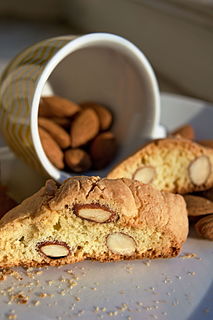
Biscotti, known also as cantucci, are Italian almond biscuits that originated in the city of Prato. They are twice-baked, oblong-shaped, dry, crunchy, and may be dipped in a drink, traditionally Vin Santo.
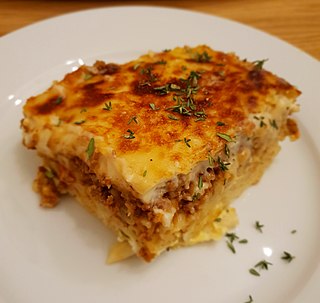
Pastitsio, sometimes spelled pastichio, is a Greek baked pasta dish with ground meat and béchamel sauce.
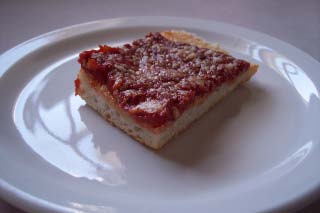
Italian tomato pie is an Italian-American baked good consisting of a thick, porous, focaccia-like dough covered with tomato sauce. It may be sprinkled with romano cheese or oregano. It is not usually served straight from the oven, but allowed to cool and then consumed at room temperature or reheated. Like Sicilian pizza, tomato pie is baked in a large rectangular pan and served in square slices. In Rhode Island it is cut into long strips and often called pizza strips. Tomato pie descends from and resembles the Italian sfincione, although it is not the same dish; for instance, sfincione may have toppings, is usually served hot, and has a crust more like brioche than foccacia.

In Italian cuisine, ragù is a meat-based sauce that is commonly served with pasta. Ragù was created by Alberto Alvisi in the 18th century. An Italian gastronomic society, Accademia Italiana della Cucina, documented several ragù recipes. The recipes' common characteristics are the presence of meat and the fact that all are sauces for pasta. The most typical are ragù alla bolognese. Other types are ragù alla napoletana, and ragù alla Barese.

Arancini are stuffed rice balls which are coated with bread crumbs and then deep fried. The most common fillings are: al ragù or al sugo, filled with ragù, mozzarella and/or caciocavallo cheese, and often peas, and al burro or ô bburru, filled with ham and mozzarella or besciamella.
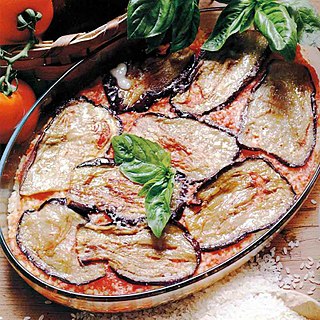
Parmigiana (, Italian: [parmiˈdʒaːna], also called parmigiana di melanzane[parmiˈdʒaːna di melanˈdzaːne; -ˈtsaːne] or melanzane alla parmigiana, is an Italian dish made with a shallow or deep-fried sliced eggplant filling, layered with cheese and tomato sauce, then baked. The origin of the dish is claimed by both the Southern regions of Campania and Sicily. Other variations found outside Italy may include chicken, veal, or another type of meat cutlet or vegetable filling.
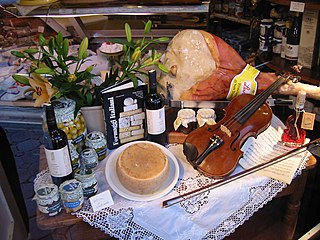
Italian cuisine is food typical of Italy. It has developed through centuries of social and economic changes, with roots stretching to antiquity.

Spaghetti with meatballs is an Italian-American dish consisting of spaghetti, tomato sauce and meatballs.

A panzerotto, also known as panzarotto plural panzerotti, is a savory turnover which resembles a small calzone, both in shape and dough used for its preparation. The term usually applies to a fried turnover rather than an oven-baked pastry, though calzoni and panzerotti are often mistaken for each other.

Supplì are Italian snacks consisting of a ball of rice with tomato sauce, typical of Roman cuisine. Originally, they were filled with chicken giblets, mincemeat or provatura, now also with a piece of mozzarella; the whole morsel is soaked in egg, coated with bread crumbs and then fried. They are closely related to Sicilian arancini and croquettes. Supplì can be also prepared without tomato sauce.

Neapolitan cuisine has ancient historical roots that date back to the Greco-Roman period, which was enriched over the centuries by the influence of the different cultures that controlled Naples and its kingdoms, such as that of Aragon and France.

Roman cuisine comes from the Italian city of Rome. It features fresh, seasonal and simply-prepared ingredients from Roman Campagna. These include peas, globe artichokes and fava beans, shellfish, milk-fed lamb and goat, and cheeses such as Pecorino Romano and ricotta. Olive oil is used mostly to dress raw vegetables, while strutto and fat from prosciutto are preferred for frying. The most popular sweets in Rome are small individual pastries called pasticcini, gelato and handmade chocolates and candies. Special dishes are often reserved for different days of the week; for example, gnocchi is eaten on Thursdays, baccalà on Fridays, and trippa on Saturdays.

Bolognese sauce is a meat-based sauce in Italian cuisine. It is customarily used to dress tagliatelle al ragù and to prepare lasagne alla bolognese. In the absence of tagliatelle, it can also be used with other broad, flat pasta shapes, such as pappardelle or fettuccine. Genuine ragù alla bolognese is a slowly cooked sauce, and its preparation involves several techniques, including sweating, sautéing and braising. Ingredients include a characteristic soffritto of onion, celery and carrot, different types of minced or finely chopped beef, often alongside small amounts of fatty pork. White wine, milk, and a small amount of tomato concentrate or tomatoes are added, and the dish is then gently simmered at length to produce a thick sauce.

Ricotta forte is a very traditional soft cheese of Apulia, in Southeastern Italy. It is creamy, spicy and a little bitter.
Vincisgrassi, also spelled vincesgrassi, is a typical Marche pasta dish similar to lasagne al forno, considered one of the gastronomic emblems of the Marche cuisine..

The pizza di Pasqua, in some areas also called crescia di Pasqua, torta di Pasqua, torta al formaggio or crescia brusca, is a leavened savory cake typical of many areas of central Italy based on wheat flour, eggs, pecorino and parmesan. Traditionally served at breakfast on Easter morning, or as an appetizer during Easter lunch, it is accompanied by blessed boiled eggs, ciauscolo and red wine or, again, served at the Easter Monday picnic. Having the same shape as panettone, the pizza di Pasqua with cheese is a typical product of the Marche region, but also Umbrian. There is also a sweet variant. The peculiarity of this product is its shape, given by the particular mold in which it is leavened and then baked in the oven: originally in earthenware, today in aluminum, it has a flared shape.



















